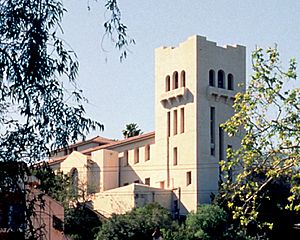Southwest Museum of the American Indian facts for kids

Museum building as seen from Sycamore Grove Park
|
|
| Former name | Southwest Museum of the American Indian |
|---|---|
| Established | 1907 |
| Dissolved | 2022 |
| Location | 234 Museum Drive Los Angeles, California |
| Founder | Charles Fletcher Lummis |
| Architect | Sumner Hunt |
| Public transit access | Southwest Museum |
| Built | 1912–1914 |
| Architectural style | Mission/Spanish Revival |
| NRHP reference No. | 92001270 |
| Significant dates | |
| Added to NRHP | March 11, 2004 |
The Southwest Museum of the American Indian was a special place in Los Angeles, California. It was a museum, a library, and an archive, all about Native American history and culture. The museum was located in the Mt. Washington neighborhood, high above the Arroyo Seco stream.
The museum was once owned by the Autry Museum of the American West. Its main focus was on Native American cultures. It also had many items from pre-Hispanic times, the Spanish colonial period, and Western American art.
The museum had huge collections, especially from:
- American Indians of the Great Plains
- American Indians of California
- American Indians of the Northwest Coast
Many of these items were later moved to other locations. Together, the Autry and the Southwest Museum hold the second-largest collection of Native American art in the country. Only the Smithsonian's National Museum of the American Indian has more.
You could reach the museum by taking the Metro A Line train. The Southwest Museum station was right down the hill. From there, a short walk led to an entrance on Museum Drive. This entrance opened into a long tunnel. This tunnel used to have cool displays, but they were moved by the Autry Museum. At the end of the tunnel, an elevator took visitors up to the museum's main area.
The Southwest Museum officially closed its doors in September 2022.
Contents
The Museum's Story
How the Museum Started
The Southwest Museum was founded by Charles Fletcher Lummis. He was an anthropologist, a historian, a journalist, and a photographer. Lummis started a group called the Southwest Society. With help from city leaders and money from a lawyer named Joseph Scott, the Southwest Museum opened in 1907.
The museum's collection was first shown in downtown Los Angeles. It moved a couple of times before finding its permanent home in Mt. Washington in 1914.
Building the Museum
The main museum building, finished in 1914, was designed by architects Sumner P. Hunt and Silas Reese Burns. Later, more parts were added. The Caroline Boeing Poole Wing of Basketry, which held many woven baskets, was completed in 1941. The Braun Research Library, a place for books and research, was added in 1971.
Important People at the Museum
Many important people helped lead the museum over the years. Frederick Russell Burnham, a famous military scout, was an early president. Carl Dentzel, a well-known historian, was the museum's director for many years, from 1955 to 1980.
In 2003, the museum faced financial challenges. It became part of the Autry Museum, which called it the Mt. Washington Campus. The museum stopped being open full-time and finally closed completely in September 2022. The museum's collections were moved to a new, special storage building in October 2022.
Future of the Site
For many years, there were discussions about what would happen to the old museum building. The Autry Museum worked with the National Trust for Historic Preservation and the City of Los Angeles to make a plan. In 2015, the Southwest Museum was named a National Treasure. This means it's a very important historic place.
In 2019, the Autry and the National Trust looked for ideas to bring the historic campus back to life. As of 2022, the Autry Museum decided not to turn the building into a museum again. This would cost a lot of money. Instead, they are looking to sell the building.
More to Explore

